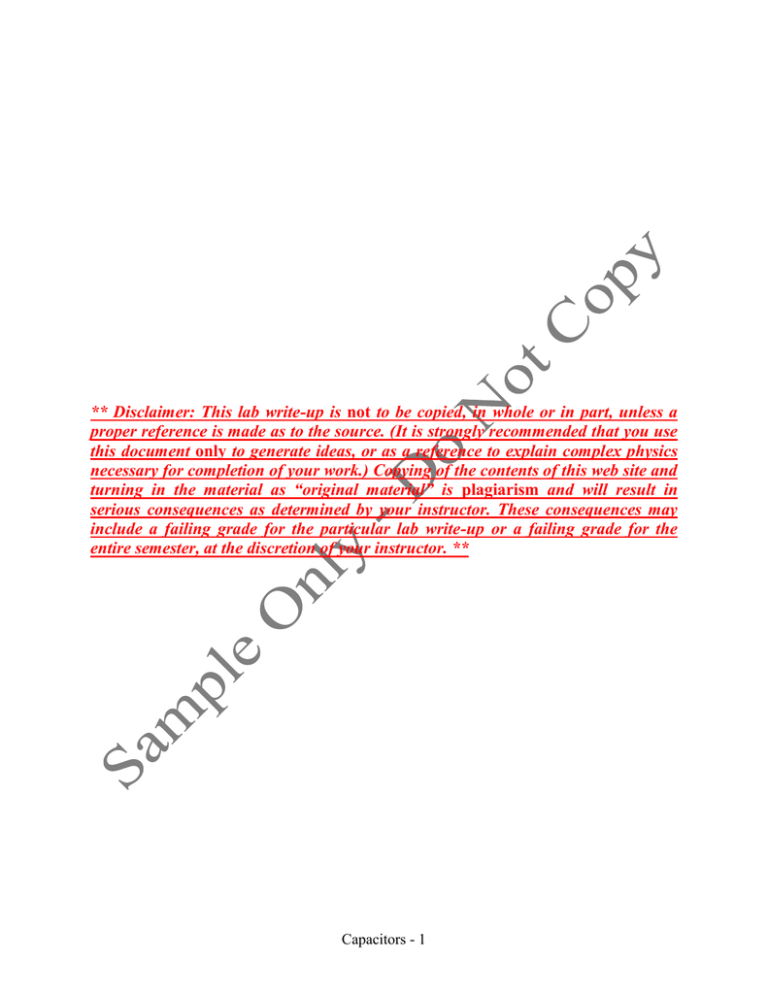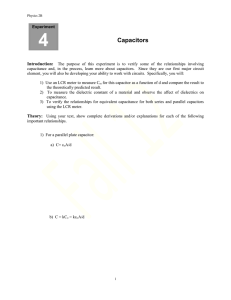** Disclaimer: This lab write-up is
advertisement

** Disclaimer: This lab write-up is not to be copied, in whole or in part, unless a proper reference is made as to the source. (It is strongly recommended that you use this document only to generate ideas, or as a reference to explain complex physics necessary for completion of your work.) Copying of the contents of this web site and turning in the material as “original material” is plagiarism and will result in serious consequences as determined by your instructor. These consequences may include a failing grade for the particular lab write-up or a failing grade for the entire semester, at the discretion of your instructor. ** Capacitors - 1 Lab 5: Capacitors Name: PES 216 Report Lab Station: Objective The purpose of this lab was to determine how to measure the capacitance of a capacitor and how capacitors function in series and parallel in a circuit according to Kirchhoff’s Rules. Data and Calculations Part A – Measuring Capacitance: Figure 1: Schematic of the RC circuit built to measure the actual capacitance of provided capacitors. Part B1 – Big Red Capacitor: Capacitors - 2 We used Logger Pro to provide a best-fit line for the data captured during the charging of the capacitor. ' Potential ' Vo * (1 exp( t 0 / RC )) Vo [volts] 1.538 +/- 0.0003851 RC [sec] 0.5115 +/- 0.001091 During the experiment it was noted that the resistance substitution box used in the circuit was set to the following resistance: Resistance [ohms] 400 M C 0.5115 sec 1.27875 F 400000 % difference CTheory C Measured CTheory Capacitors - 3 100% % difference 1.00 F 1.27875 F 100% 27.875% 1.00 F Part B2 – Small Orange Capacitor: We used Logger Pro to provide a best-fit line for the data captured during the charging of the capacitor. ' Potential ' Vo * (1 exp( t 0 / RC )) Vo [volts] 1.538 +/- 0.0003851 RC [sec] 0.2182 +/- 0.007126 Resistance [ohms] 400 M C 0.2182 sec 0.5455 F 400000 Capacitors - 4 % difference 0.56 F 0.5455 F 100% 2.589% 0.56 F Part B – Capacitors in Series and Parallel: 1 1 Series: CT C1 C 2 1 Using the values from Part A that we measure, theoretically the total capacitance for the two capacitors in series should be: 1 1 CT 1.27875 F 0.5455 F 1 CT 0.3824 F Parallel: CT C1 C2 Using the values from Part A that we measure, theoretically the total capacitance for the two capacitors in parallel should be: CT 1.27875 F 0.5455 F Capacitors - 5 CT 1.82425 F Part B1 – Capacitors in Series: We used Logger Pro to provide a best-fit line for the data captured during the charging of the capacitor. ' Potential ' Vo * (1 exp( t 0 / RC )) Vo [volts] 1.025 +/- 0.0001918 RC [sec] 0.2024 +/- 0.005266 Resistance [ohms] 530 M C % difference 0.2024 sec 0.38189 F 530000 0.3824 F 0.38189 F 100% 0.133% 0.3824 F Capacitors - 6 Part B2 – Capacitors in Parallel: We used Logger Pro to provide a best-fit line for the data captured during the charging of the capacitor. ' Potential ' Vo * (1 exp( t 0 / RC )) Vo [volts] 1.022 +/- 0.001856 RC [sec] 0.9692 +/- 0.01049 Resistance [ohms] 530 M C % difference 0.9692 sec 1.8287 F 530000 1.82425 F 1.8287 F 100% 2.439% 1.82425 F Capacitors - 7 Conclusion Here is an example of a “real world” occurrence of charging/discharging a capacitor. This explains the high-pitched noise (that starts with a low tone and increases to a high tone) you hear after you trigger the flash on a camera. You write the details. Include your answer here. Use complete sentences!!!! Capacitors - 8 ** NOTE: There are several components of error which could significantly modify the results of this experiment. Some of these are listed below: Heat Age Humidity Short circuit Fuse Bad power supply (recall we used the DMM to attempt to alleviate this problem.) Bad connections (in protoboard) Insulation Length of wire and Gauge accuracy of wire (copper) Bad power supply (recall we used the DMM to attempt to alleviate this problem.) Buckling, bending, etc… of wire Elemental components/material makeup of the wire ?? It is recommended that you take these and explain the “why” part of each for your results and conclusions sections – and possibly what could have been done (if anything) to minimize the effects of these errors. Capacitors - 9






